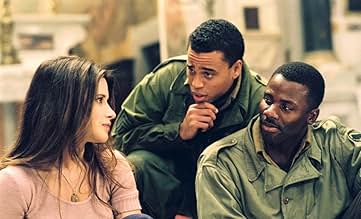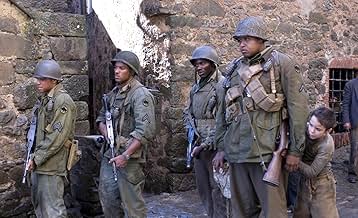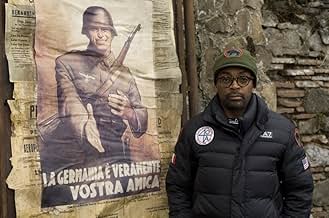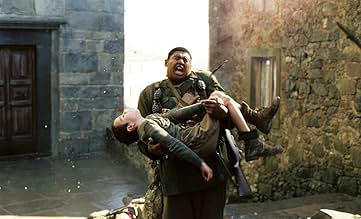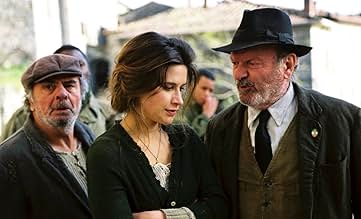NOTE IMDb
6,1/10
20 k
MA NOTE
Italie, 1944. L'histoire de quatre soldats américains noirs piégés dans un village de Toscane pendant la Seconde Guerre mondiale.Italie, 1944. L'histoire de quatre soldats américains noirs piégés dans un village de Toscane pendant la Seconde Guerre mondiale.Italie, 1944. L'histoire de quatre soldats américains noirs piégés dans un village de Toscane pendant la Seconde Guerre mondiale.
- Récompenses
- 1 victoire et 10 nominations au total
Lidia Biondi
- Natalina
- (as Lydia Biondi)
Avis à la une
I don't know why everyone here keeps telling that this movie is bad, because it's definitely rather good. Only thing to take out of plot was mas execution of civilians which I couldn't take and just pressed "skip the scene". From the very beginning, where troops advancing to enemy lines got under artillery and machine-gun fire dialogs are interesting and realistic, let alone so called hook from first minutes where black postman kills his customer for no apparent reason. It cost $45M to produce and true that commercially it has become a screw up but not everything revolves around money. I say it has no major faults in plot, definitely no more than any other picture does. And that story with Italian girl - Renata was her name, all is fair in love and war. Definitely worth seeing. Comparison to Save Private Ryan is not applicable.
Lee makes a European film allowing philosophical questions and moral questions to supplant desire for personal satisfaction and identifiable this is a Spike Lee film signature patterns. There are a number of excellent directorial decisions in this film. Lee's camera is sensitive, gentle and sincere. He shows us the many ways our eyes are deceived and how much of what we perceive is illusion. I think its a great film that is inspirational, has meaning and is both emotionally and intellectually satisfying. I hope that Lee will continue to make films outside his comfort zone and articulate events from the African American experience around the world to show our contribution to history and civilization.
I attended the world premier of Miracle at St. Anna at Toronto International Film Festival. Unfortunately as much as I respect Spike Lee as a filmmaker I thought the movie was a bit dull and kind of boring. At 166 minutes I found that the movie was overlong and dragged too much. I became restless after awhile as the movie progressed. The story didn't seem to go anywhere, was uninteresting and I had trouble connecting with it. It was hard to follow at times as well. The movie jumped all over the place at several points to different years in the history of the characters. I found this to be jarring and irritating. Spike Lee should have taken more time to edit his film because each of the scenes went longer than they should have. It's not the worst movie I have ever seen although it could have been better. My expectations were high. I came away somewhat disappointed.
MIRACLE AT ST. ANNA got panned pretty severely. And I can see why. Lacking cohesion and hopscotching around like a child with A-D-D, the story is tough to follow. And what about the title? Exactly what is "the Miracle"? Some might say it's that this film ever got made. But there are some upsides to it that I think make this a semi-watchable flick.
The first plus is that it focuses on a little known regiment of black WW II fighters called "The Buffalo Soldiers." Spike Lee had apparently been aching to do another "black story" and found his muse in Nazi occupied Italy.
Although there's been some bashing related to overacting on the main characters' parts, I didn't find that to be the case. Derek Luke, Michael Ealy, and the rest of these band of brothers did fine in my eyes. Although Spike did have them doing things that weren't being done during this time (specifically the "high five" which wasn't realized until the late 70s), I did find their delivery of the story to be engaging enough, and kept me watching during its entire, lengthy, 2 hours and 40 minute run time.
I also really liked the on-site filming locations in Italy, which gave the entire production a very real quality. The cobbled streets, twisted landscape, and ancient-looking buildings were all well-shown in the film and had me ogling at various times.
But, as they say, all good things must come to an end. Although Spike Lee tries admirably to keep the story together, he too often wanders off on tangents that have nothing to do with the story. One particularly infuriating scene involves John Leguizamo (THE HAPPENING). He's in modern day Italy with his lover and his only use for being in the film is that he throws a newspaper out a window so that it lands on a man's table. Why couldn't the man have simply seen it at a newsstand? Why the whole set up with Leguizamo and the hot chick? Sex for the sake of sex, perhaps? The other, less infuriating, item that shows Spike wandering away was when he films the Buffalo boys being refused food service at a place back in the States before they were shipped overseas. Why this played a role in the film and what it had to do with the Miracle is anyone's guess.
Finally, there's the tough sell of the Miracle itself. Although people can debate what qualifies as a miracle, I think most would say it equates to something supernatural that cannot be explained by normal evidence. And here lies perhaps the biggest problem for Miracle at St. Anna. There really isn't a miracle. Perhaps it's well enough that one of the Buffalo men made it home and found his way to peace. Perhaps it's that the world spun and allowed the last surviving Buffalo Soldier to avenge the people of St. Anna and his fallen brothers. Perhaps ...but not likely.
The first plus is that it focuses on a little known regiment of black WW II fighters called "The Buffalo Soldiers." Spike Lee had apparently been aching to do another "black story" and found his muse in Nazi occupied Italy.
Although there's been some bashing related to overacting on the main characters' parts, I didn't find that to be the case. Derek Luke, Michael Ealy, and the rest of these band of brothers did fine in my eyes. Although Spike did have them doing things that weren't being done during this time (specifically the "high five" which wasn't realized until the late 70s), I did find their delivery of the story to be engaging enough, and kept me watching during its entire, lengthy, 2 hours and 40 minute run time.
I also really liked the on-site filming locations in Italy, which gave the entire production a very real quality. The cobbled streets, twisted landscape, and ancient-looking buildings were all well-shown in the film and had me ogling at various times.
But, as they say, all good things must come to an end. Although Spike Lee tries admirably to keep the story together, he too often wanders off on tangents that have nothing to do with the story. One particularly infuriating scene involves John Leguizamo (THE HAPPENING). He's in modern day Italy with his lover and his only use for being in the film is that he throws a newspaper out a window so that it lands on a man's table. Why couldn't the man have simply seen it at a newsstand? Why the whole set up with Leguizamo and the hot chick? Sex for the sake of sex, perhaps? The other, less infuriating, item that shows Spike wandering away was when he films the Buffalo boys being refused food service at a place back in the States before they were shipped overseas. Why this played a role in the film and what it had to do with the Miracle is anyone's guess.
Finally, there's the tough sell of the Miracle itself. Although people can debate what qualifies as a miracle, I think most would say it equates to something supernatural that cannot be explained by normal evidence. And here lies perhaps the biggest problem for Miracle at St. Anna. There really isn't a miracle. Perhaps it's well enough that one of the Buffalo men made it home and found his way to peace. Perhaps it's that the world spun and allowed the last surviving Buffalo Soldier to avenge the people of St. Anna and his fallen brothers. Perhaps ...but not likely.
As a black man who fully believes in black pride and progress, I must say I am truly disappointed with spike lee's new movie right now. I don't know where to begin in regards to expressing my disappointment but I will try. Considering how spike tries to come off as being very afro-centric, his portrayal of black characters was very insulting. There were so many typical blacks in film stereotypes in the movie that I just shook my head most of the time. For instance you had a black man with a gold tooth and stocking cap on, another that was enormous in size but brainless and country, and then to put the cherry on top the 2 guys are fighting over a white woman they met like 2 days ago and kept drooling over. Contrary to popular belief most of the white American soldiers didn't look like the actors in the movies made in the 50's and 60's. The actors looks were ploy to just associate good looks and chivalry with American soldiers in order to build moral for soldiers when they left and came home and to keep ppl interested in the movie. Another thing that really bothered me was that black films don't always need to be funny or trying to evoke laughter. This movie was suppose to be dramatic touching upon a serious subject and should have been directed in the same manner. Then the scoring of the movie was horrible. Even the little parts where he tries to show difference between African Americans and black puerto ricans was off and unnecessary. During that time those hispanics that were black or mulatto didn't try to act like there was a difference between the 2 other than language and maybe certain foods because they faced the same discriminations in PR, DR, and CUBA as in the US. These are just some of the issues I had with this movie. I think antoine faqua, who did training day and arthur, should have done this movie. I am just waiting now to see the mockery of hannibal that vin diesel does.
Le saviez-vous
- AnecdotesSamuel L. Jackson turned down the offer to play as Corporal Hector Negron to work on Harcelés (2008).
- GaffesWhen the professor examines the marble head he recognizes it as the "Primavera" from Santa Trinità in Florence. He assumes it is by Bartolomeo Ammannati, but the bridge is by Ammannati; the sculpture is by Pietro Francavilla.
- Citations
Livingston: Safety is the greatest risk of all, because safety leaves no room for miracles and miracles are the only sure thing in life.
- Bandes originalesFaccetta Nera
Written by Gustavo Cacini (as Cascini) / Giuseppe Micheli (as Micheli) / Vincenzo Raimondi / Arnaldo Stazzonelli (as Stazzonelli)
Edizioni Bixio C.E.M.S.A.
Meilleurs choix
Connectez-vous pour évaluer et suivre la liste de favoris afin de recevoir des recommandations personnalisées
Détails
- Date de sortie
- Pays d’origine
- Site officiel
- Langues
- Aussi connu sous le nom de
- Miracle at St. Anna
- Lieux de tournage
- Sociétés de production
- Voir plus de crédits d'entreprise sur IMDbPro
Box-office
- Budget
- 45 000 000 $US (estimé)
- Montant brut aux États-Unis et au Canada
- 7 919 117 $US
- Week-end de sortie aux États-Unis et au Canada
- 3 477 996 $US
- 28 sept. 2008
- Montant brut mondial
- 9 333 654 $US
- Durée
- 2h 40min(160 min)
- Couleur
- Mixage
- Rapport de forme
- 2.39 : 1
Contribuer à cette page
Suggérer une modification ou ajouter du contenu manquant







